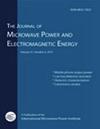基于奇异值分解截断的微波加热温度分布计算
IF 1.5
4区 工程技术
Q4 ENGINEERING, CHEMICAL
Journal of Microwave Power and Electromagnetic Energy
Pub Date : 2022-11-04
DOI:10.1080/08327823.2022.2137748
引用次数: 2
摘要
摘要在具有无限维特征的微波加热数学模型中,传统的数值方法难以提高计算效率。在这项工作中,我们提出了一种快速准确的方法来计算微波加热下材料的温度分布。首先,通过将无限维热传导偏微分方程(PDE)模型降阶为有限维常微分方程(ODE)模型,分析了模型阶数选择与求解精度之间的关系。此外,还分析了不同边界条件对全球温度分布的影响。其次,在齐次边界条件下,采用奇异值分解(SVD)截断法计算平衡转换矩阵;利用该矩阵,进一步得到了低维微波加热ODE模型。最后,数值模拟结果表明,均方根误差(RMSE)仅为0.07,最大相对误差仅为−0.85%。平衡转换矩阵的计算时间为2.12 ~ 3.00 ms,模型计算时间缩短了97.78%。我们将计算得到的温升曲线与常规COMSOL模型得到的温升曲线进行了比较。采用奇异值分解截断法对微波加热模型进行了高效、准确的求解。本文章由计算机程序翻译,如有差异,请以英文原文为准。
Calculation of microwave heating temperature distribution based on SVD truncation
Abstract In mathematical models of microwave heating with infinite-dimensional characteristics, it is difficult to use traditional numerical methods to improve computational efficiency. In this work, we propose a fast and accurate method to calculate the temperature distribution of materials under microwave heating. First, we analysed the relationship between the choice of model order and the solution accuracy by downscaling the infinite-dimensional heat conduction partial differential equation (PDE) model into a finite-dimensional ordinary differential equation (ODE) model. Additionally, the effect of different boundary conditions on the global temperature distribution was analysed. Second, the equilibrium conversion matrix was calculated using the singular value decomposition (SVD) truncation method under homogeneous boundary conditions. Using this matrix, a lower-dimensional microwave heating ODE model was further obtained. Finally, the numerical simulation results showed that the root mean square error (RMSE) was only 0.07 and the maximum relative error was only −0.85%. The computation time of the equilibrium conversion matrix was 2.12 ∼ 3.00 ms, and the model calculation time was reduced by 97.78%. We compared the calculated temperature rise curves with those obtained using the conventional COMSOL model. The SVD truncation method achieved an efficient and accurate solution for the microwave heating model.
求助全文
通过发布文献求助,成功后即可免费获取论文全文。
去求助
来源期刊

Journal of Microwave Power and Electromagnetic Energy
ENGINEERING, CHEMICAL-ENGINEERING, ELECTRICAL & ELECTRONIC
CiteScore
2.50
自引率
6.70%
发文量
21
期刊介绍:
The Journal of the Microwave Power Energy (JMPEE) is a quarterly publication of the International Microwave Power Institute (IMPI), aimed to be one of the primary sources of the most reliable information in the arts and sciences of microwave and RF technology. JMPEE provides space to engineers and researchers for presenting papers about non-communication applications of microwave and RF, mostly industrial, scientific, medical and instrumentation. Topics include, but are not limited to: applications in materials science and nanotechnology, characterization of biological tissues, food industry applications, green chemistry, health and therapeutic applications, microwave chemistry, microwave processing of materials, soil remediation, and waste processing.
 求助内容:
求助内容: 应助结果提醒方式:
应助结果提醒方式:


